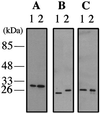Three proliferating cell nuclear antigen-like proteins found in the hyperthermophilic archaeon Aeropyrum pernix: interactions with the two DNA polymerases
- PMID: 11790738
- PMCID: PMC139509
- DOI: 10.1128/JB.184.3.687-694.2002
Three proliferating cell nuclear antigen-like proteins found in the hyperthermophilic archaeon Aeropyrum pernix: interactions with the two DNA polymerases
Abstract
Proliferating cell nuclear antigen (PCNA) is an essential component in the eukaryotic DNA replication machinery, in which it works for tethering DNA polymerases on the DNA template to accomplish processive DNA synthesis. The PCNA also interacts with many other proteins in important cellular processes, including cell cycle control, DNA repair, and an apoptotic pathway in the domain EUCARYA: We identified three genes encoding PCNA-like sequences in the genome of Aeropyrum pernix, a crenarchaeal archaeon. We cloned and expressed these genes in Escherichia coli and analyzed the gene products. All three PCNA homologs stimulated the primer extension activities of the two DNA polymerases, polymerase I (Pol I) and Pol II, identified in A. pernix to various extents, among which A. pernix PCNA 3 (ApePCNA3) provided a most remarkable effect on both Pol I and Pol II. The three proteins were confirmed to exist in the A. pernix cells. These results suggest that the three PCNAs work as the processivity factor of DNA polymerases in A. pernix cells under different conditions. In Eucarya, three checkpoint proteins, Hus1, Rad1, and Rad9, have been proposed to form a PCNA-like ring structure and may work as a sliding clamp for the translesion DNA polymerases. Therefore, it is very interesting that three active PCNAs were found in one archaeal cell. Further analyses are necessary to determine whether each PCNA has specific roles, and moreover, how they reveal different functions in the cells.
Figures






Similar articles
-
Functional interactions of a homolog of proliferating cell nuclear antigen with DNA polymerases in Archaea.J Bacteriol. 1999 Nov;181(21):6591-9. doi: 10.1128/JB.181.21.6591-6599.1999. J Bacteriol. 1999. PMID: 10542158 Free PMC article.
-
Specific interactions of three proliferating cell nuclear antigens with replication-related proteins in Aeropyrum pernix.Mol Microbiol. 2007 Apr;64(2):308-18. doi: 10.1111/j.1365-2958.2007.05645.x. Mol Microbiol. 2007. PMID: 17493121
-
A single amino acid substitution in the DNA-binding domain of Aeropyrum pernix DNA ligase impairs its interaction with proliferating cell nuclear antigen.Extremophiles. 2007 Sep;11(5):675-84. doi: 10.1007/s00792-007-0083-0. Epub 2007 May 9. Extremophiles. 2007. PMID: 17487442
-
'PIPs' in DNA polymerase: PCNA interaction affairs.Biochem Soc Trans. 2020 Dec 18;48(6):2811-2822. doi: 10.1042/BST20200678. Biochem Soc Trans. 2020. PMID: 33196097 Review.
-
Functions of Multiple Clamp and Clamp-Loader Complexes in Eukaryotic DNA Replication.Adv Exp Med Biol. 2017;1042:135-162. doi: 10.1007/978-981-10-6955-0_7. Adv Exp Med Biol. 2017. PMID: 29357057 Review.
Cited by
-
Structure of an XPF endonuclease with and without DNA suggests a model for substrate recognition.EMBO J. 2005 Mar 9;24(5):895-905. doi: 10.1038/sj.emboj.7600581. Epub 2005 Feb 17. EMBO J. 2005. PMID: 15719018 Free PMC article.
-
Essential and non-essential DNA replication genes in the model halophilic Archaeon, Halobacterium sp. NRC-1.BMC Genet. 2007 Jun 8;8:31. doi: 10.1186/1471-2156-8-31. BMC Genet. 2007. PMID: 17559652 Free PMC article.
-
Coevolutionary and Phylogenetic Analysis of Mimiviral Replication Machinery Suggest the Cellular Origin of Mimiviruses.Mol Biol Evol. 2021 May 4;38(5):2014-2029. doi: 10.1093/molbev/msab003. Mol Biol Evol. 2021. PMID: 33570580 Free PMC article.
-
Replication clamps and clamp loaders.Cold Spring Harb Perspect Biol. 2013 Apr 1;5(4):a010165. doi: 10.1101/cshperspect.a010165. Cold Spring Harb Perspect Biol. 2013. PMID: 23545418 Free PMC article. Review.
-
DNA replication in the archaea.Microbiol Mol Biol Rev. 2006 Dec;70(4):876-87. doi: 10.1128/MMBR.00029-06. Microbiol Mol Biol Rev. 2006. PMID: 17158702 Free PMC article. Review.
References
-
- Bocquier, A. A., L. Liu, I. K. O. Cann, K. Komori, D. Kohda, and Y. Ishino. 2001. Archaeal primase: bridging the gap between RNA and DNA polymerase. Curr. Biol. 11:452–456. - PubMed
-
- Cai, R. L., Y. Yan-Neale, M. A. Cueto, H. Xu, and D. Cohen. 2000. HDAC1, a histone deacetylase, forms a complex with Hus1 and Rad9, two G2/M checkpoint Rad proteins. J. Biol. Chem. 275:27909–27916. - PubMed
Publication types
MeSH terms
Substances
LinkOut - more resources
Full Text Sources
Other Literature Sources
Research Materials
Miscellaneous

